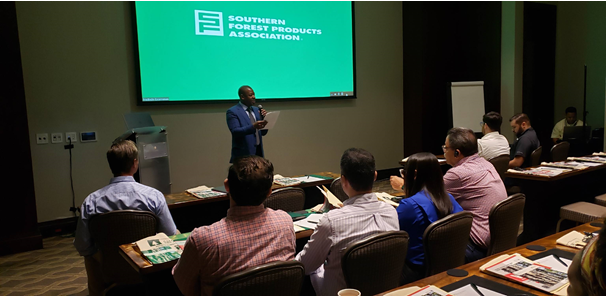





“Excellent initiative, very well-prepared and experienced speakers.”
“Very good information, very useful.”
“The presentations were very good for a person like me that is in process of learning about wood products.”
“Excellent presentations by all the speakers. the message was clear and accurate.”
“The speakers are experts; they have great domain of their topics and the capacity to present with simplicity.”
This is just some of the feedback from participants who attended the Southern Forest Products Association’s seminars on Southern Pine lumber insights and proper wood-frame construction practices in Santo Domingo and Santiago, Dominican Republic in November 2022.
SFPA consultants Jerry Hingle, president of International Trade Associates; Lon Sibert, president of Renewable Resource Associates; and Kerlin Drake, president of Kerlin Drake Consulting provided updated information on selecting and using Southern Yellow Pine from the United States, wood grading processes, choosing the correct treated wood, executing wood-frame best practices to withstand high wind and earthquakes, and other topics of interest.
Wood-Frame Best Practices, Southern Pine Seminars
Market Overview
The Caribbean is the highest volume export market for the Southern Pine lumber industry. Exports to the Caribbean reached a record $236 million in 2018 because of the rebuilding after widespread hurricane damage that year. Shipments returned to normal levels in 2019-20 as rebuilding efforts were complete. Exports have since rebounded, reaching an all-time record in 2021 of $271.4 million. Shipments through October 2022 are down slightly but remain near record levels.
Southern Pine lumber, produced from timber grown in the Southern U.S., accounts for nearly all lumber shipments to the region, and a sizeable share of lumber consumed in the region is preservatively treated.
While the U.S. has a dominant share of these markets, it is facing competition from alternative building materials such as concrete and steel. There remains some misunderstanding of wood-frame construction practices and selecting the proper grades and sizes for the application. In such markets more accustomed to masonry construction, continuous efforts are needed to ensure correct structural application of wood products especially considering the threat of tropical weather and other frequent high wind events in the region.
Dominican Republic
The Dominican Republic is the third largest export market for U.S. softwood lumber, valued at nearly $105 million in 2021. Exports in 2022 are on track to reach $82 million. Exports of preservatively treated lumber are relatively small (valued at $4.4 million) compared to non-treated because of a good presence of treating plants on the island that import U.S. lumber and treat locally. Wood is primarily used in concrete forming, interior joinery, and some construction applications (primarily roof purlins).
The market has long been a mainstay for U.S. exporters and the U.S. faces very little competition from alternative suppliers, such as Brazil, Chile, and Honduras. Like elsewhere in the Caribbean, the biggest barrier the U.S. industry faces in the market is competition from alternative building materials and mistrust of wood-frame best practices in an area prone to hurricanes. Hence, the speakers’ emphasis on building practices for high wind.
Accomplishments and Observations
There were 53 contacts registered for the seminars, 28 participants for the event in Santo Domingo and 25 participants for the event in Santiago. USDA/FAS Agricultural Counselor for the market, Fred Giles, gave welcome remarks at the event in Santo Domingo, where 16 people attended the seminar. After Giles, remarks, Hingle proceeded with his presentations followed by Sibert. Drake provided the final presentation of the event.
Several of importers that attended the event indicated they are having problems with quality, including bundles arriving with a large number of damaged pieces, which creates problems for them as clients often place claims.
Importers that have equipment for treating wood indicated clients do not like to pay the cost for the right type of treatment and most of the people use treated pine, which is not correct for the project such as wood treated for above-ground use but applied in ground contact.
In Santiago, where 17 people attended the event, importers also indicated they are having problems with quality, but that could be a matter of buying low-grade material.
Importers from both cities indicated they also have problems with specifying certain sizes the market demands.
Participant Feedback
Feedback from participants at both events show quality concerns are among the largest issues in the Southern Pine market abroad; nevertheless, it’s considered good value for the money. Other favorable opinions are American softwoods are good for structural uses, environmentally friendly, readily available, and versatile. Participants also said the event improved their understand of American softwoods and ability to better specify product.